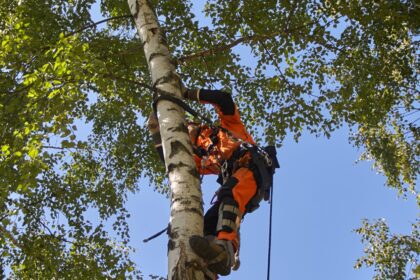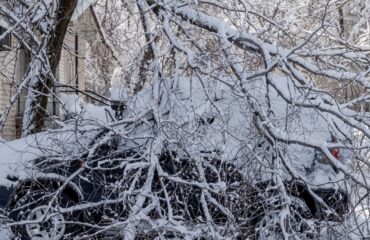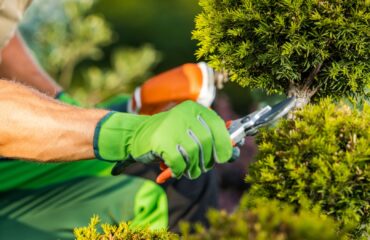
Diving Deep Into When To Hire The Professionals
When contemplating the best approach to maintaining your trees, the debate between DIY vs professional tree care often arises.
Trees stand as quiet guardians of our landscapes, offering shade, beauty, and habitats for wildlife. Their presence not only enhances our surroundings aesthetically but also benefits the environment by purifying the air, stabilizing the soil, and sequestering carbon dioxide. These remarkable beings play a crucial role in fostering biodiversity and serving as sanctuaries for birds, insects, and animals.
However, tending to these natural marvels presents a significant challenge, requiring a blend of knowledge, expertise, and unwavering commitment. The question arises: should you undertake tree care yourself or entrust it to professionals? Various factors must be considered, such as safety, proficiency, time, and cost. Tree care transcends mere watering and occasional trimming; it necessitates understanding the unique requirements of different tree species, identifying early signs of diseases or pests, and mastering proper techniques for pruning and fertilizing.
No matter what side you end up on in the DIY vs professional tree care debate, Archer Tree Services stands ready to assist you in managing these essential responsibilities with precision and ease. Our skilled arborists leverage cutting-edge tools and methodologies to tackle even the most intricate tree care challenges, guaranteeing that your trees receive optimal care. Opting for professional tree care not only saves you time and energy but also safeguards your property investment by preserving its innate beauty and well-being.
DIY vs Professional Tree Care – Pruning
Pruning trees involves selectively removing specific branches or stems to enhance the tree’s structure, health, and aesthetics. This practice is vital for promoting healthy growth, warding off diseases, and reducing the danger of falling branches, which can pose risks. Effective pruning can also increase sunlight exposure and air circulation, bolstering the tree’s overall well-being.
Do-it-Yourself Tree Pruning
DIY tree pruning entails the personal responsibility of trimming and maintaining the trees on your property. The task usually involves removing of large or inferior limbs with small tools, such as hand pruners and loppers, supplemented by a pruning saw. From a homeowner’s standpoint, household pruning is primarily applicable to small trees and shrubs, the relative size of which allows the homeowner to undertake the task from the ground safely without the use of climbing or heavy equipment. It is also ideal for regular maintenance to maintain the shape and mitigate the tree’s minor health issues.
However, pruning trees can also be a risky activity. Some of the common risks are personal injury—which can be caused by the misuse of pruning tools or not wearing safety equipment to prevent cuts, falling, and many more. Another risk is causing injury to a tree, especially if the pruner does not know the anatomy of trees or how to identify tree diseases. A wrong cut is likely to lead to a wound that exposes the tree to pests, diseases, or decay. In addition, over-pruning can cause so much stress on a tree that its capacity for growth is weakened, or it can even die. While DIY pruning is effective for manageable tasks, the work is laden with risks that must not be understated.
Professional Tree Pruning
Professional pruning is an elaborate process undertaken by arborists who are experts in tree and landscaping fields. Such professionals boast a wealth of experience and attend significant training on tree biology, soil ecology, and further development in pruning techniques. Contrary to standard procedures of DIY pruning, most professionals have specialized equipment to complete these projects, such as hydraulic pruners, chainsaws, and aerial lifts, in a manner safe yet highly effective on trees of all sizes.
Probably the biggest difference between DIY vs Professional Tree Care pruning is in the amount of expertise involved. Professional arborists possess the skills needed to assess tree health, diagnose problems, and prescribe the right kind of pruning necessary to ensure long-term tree vitality. They make cuts according to industry best practices to ensure all are done properly and in a manner that minimizes the potential for disease and decay. In addition, practitioners prepare species-specific and condition-based treatment plans to increase every tree’s potential growth and health.
Professional tree pruning is an expert-driven process that not only ensures the safety and health of your trees but also enhances the overall beauty and stability of your landscape. With their specialized skills and tools, professionals can deliver superior results that DIY efforts often cannot match.
DIY vs Professional Tree Care – Removal
Tree removal entails completely eliminating a tree from your property, which may be necessary because of diseases, risk factors, and improvement in the landscape. Starting out with a detailed assessment of the health status of the tree and the environment, the safest possible method will be used within that area. Tree removal is very complex and dangerous, requiring cautious planning and execution to avoid damage to structures, power lines, and nearby landscapes. Many homeowners and property managers, when deciding between DIY vs professional tree care, choose to hire professionals with the necessary tools and expertise—for instance, climbing, rigging, and controlled felling—to effectively and safely do the job.
DIY Tree Removal
DIY tree removal entrusts homeowners with cutting down and removing trees on their property. This is typically undertaken with smaller trees, with no interfering power lines, buildings, or other hazardous structures and features in the surrounding area. The basic tools required to carry out a DIY tree removal will be a handsaw or chainsaw and potentially rope to hold it for stability and direction as it falls. Further, homeowners should protect themselves with helmets, safety goggles, and gloves to avoid potential damage.
Any DIY removal of a tree would follow some critical steps:
- Evaluation: Before starting the work, the tree owner needs to evaluate the size and condition of the tree and its surroundings to judge whether the situation is safe for DIY without professional intervention.
- Preparation: Clear the area around the tree to avoid damage to property and ensure a clear escape route.
- Cutting: Utilize appropriate cutting techniques to ensure the tree falls in the intended direction. This involves making strategic cuts to control the fall.
- Safety Measures: Always wear protective equipment and follow safety guidelines to prevent accidents and injuries
- Clearing: Clear the remains of the felled tree, chipping wood where possible, in preparation for further processing for use or disposal.
While DIY vs professional tree care removal can be a cheap way to get the job done, measuring the risks and complexities involved in larger trees or those located next to any possible obstruction is very necessary.
Professional Tree Removal
Professional tree removal is a high-skilled service performed by highly trained, professional arborists using modern tools and techniques for the sake of safety and efficiency. Unlike DIY tree removal, which is invariably limited by knowledge and equipment, the professional variant has advantages like the following: knowledge about tree biology, disease identification, and the required removal techniques that will help arborists evaluate and handle any complex job.
- Advanced Equipment: Most professionals are endowed with the use of advanced equipment, such as cranes, wood chippers, and stump grinders, that are usually unavailable to many people in the do-it-yourself category. Such equipment makes sure that a tree is felled in the shortest time and with absolute safety,—cutting down unnecessary hassle in surrounding areas.
- Safety: Safety is a big factor in professional tree removal. Organizations have designed and carried out the process to contain the risks of hurt and property damage. Arborists are trained to manage hazardous conditions, like proximity to power lines and unstable trees, following stringent safety procedures.
- Efficiency: With a team of experts and the right tools, professional tree removal is often completed more swiftly and smoothly than a DIY effort that might take considerably longer.
- Damage Minimization: Professionals employ techniques to control the fall direction and dismantle trees in sections when necessary, reducing the risk of damage to nearby structures, landscapes, and utilities.
- Clean-Up: Professional services will not only remove the tree but also clean up thoroughly and remove debris, with the added advantage of stump grinding, which leaves your property looking neat and ready for its next phase of landscaping.
Overall, professional tree removal is not just about cutting down a tree; it is a comprehensive service that prioritizes safety, efficiency, and the health of your property.
DIY vs Professional Tree Care – Stump Grinding
Stump grinding is the process of removing a tree stump and its roots post-cutting. This task is carried out using a specialized machine known as a stump grinder, which grinds the stump and roots into small wood chips. The resulting mulch can be utilized as ground cover in your garden, serving as a natural method to enrich the soil. Stump grinding plays a vital role in averting tripping hazards, pest issues, and potential regrowth from the remaining tree remnants. By thoroughly eradicating the stump and roots, you ensure a tidier, safer, and visually appealing landscape. This process not only enhances your property’s overall aesthetics but also bolsters its long-term health and functionality.
DIY Stump Grinding
DIY stump grinding can be a practical solution for homeowners looking to remove tree stumps on their own without professional assistance. This approach involves renting or purchasing a stump grinder, which is a powerful machine designed specifically to grind down tree stumps and roots into small wood chips. While it can save money, it’s important to understand the process and the necessary precautions to ensure safety and effectiveness.
- Renting or Purchasing Equipment: Evaluate stump grinder options suitable for your task.
- Site Preparation: Remove debris and rocks from the area surrounding the stump.
- Safety Precautions: Wear safety gear—gloves, eyewear, ear protection, and boots.
- Operating the Grinder: Follow the user manual to gradually grind the tree stump and roots.
- Debris Management: Collect and use or dispose of wood chips appropriately.
- Soil Treatment: Level and treat the ground, if necessary, for future landscaping.
DIY stump grinding can be an effective and budget-friendly option if approached with thorough preparation, necessary precautions, and an understanding of the machine’s operation.
Professional Stump Grinding
Professional stump grinding involves the act of hiring properly trained arborists or trained professionals in landscaping who have obtained professional skills to ensure the ultimate eradication of tree stumps using high-quality equipment. There is a great deal of difference between DIY vs professional tree care stump grinding, including:
- No Rental on Expensive Equipment: While in DIY stump grinding, you will have to rent or buy a stump grinder, professional services already have the machines. This erases the headache and cost of renting specialized machinery.
- Expert Handling of Equipment: Professional arborists are experienced running stump grinders safely and effectively. Their expertise ensures that the stump is removed thoroughly without causing damage to the surrounding area.
- Thorough Clean-up: After the stump is ground, the clean-up is mostly done by the professionals. All of the grindings are collected and removed, leaving it clean and ready for any subsequent landscaping. The thorough clean-up services also save your time.
- Safety Assurance: Stump grinding, when done by professionals, ensures minimal risks involved. The arborists will both use strict safety measures and accurate, updated methods of operation in hazardous situations with proper protective gear.
- Time Efficiency: A professional removes the stump in a fraction of the time of a DIY job. The time it saves you can free up your schedule and reduce that headache which comes along with lengthy yard work.
Professional stump grinding provides superior, hassle-free solutions for eliminating tree stumps to ensure safety, efficiency, and a finely kept landscape.
DIY vs Professional Tree Care – Fertilizing and Mulching
Maintaining a lush and visually appealing landscape often requires thoughtful decisions on tree care, mulching, and fertilization. Homeowners must decide where they land in the DIY vs professional tree care deliberation. While DIY methods offer savings and immediate results, they carry risks in terms of safety and efficacy. Conversely, professional services bring expertise, holistic solutions, and potentially higher initial expenses.
DIY Fertilizing and Mulching
DIY fertilizing and mulching are procedures whereby a homeowner personally applies fertilizer and mulch to the gardens or the lawn to keep it healthy and in good condition. In this approach, there is an opportunity to allow for customization of products used and timing based on the needs of the garden. However, it does demand some knowledge of the key principles and may be quite labor-intensive.
- Choosing the Right Products: Proper fertilizers and mulches can be hard to pick out because they have to fit both your soil type and the needs of your plants. There are plusses and minuses to organic and synthetic types, all of which must be taken into consideration.
- Soil Testing: Before the application of any fertilizer, the soil should be tested to determine the pH value and content of nutrients in the soil. This becomes necessary to administer the right type of fertilizer as it shall rectify the deficiency of the soil and achieve an appropriate balance for the healthy growth of plants.
- Measurement and Mixing: While applying fertilizers, correct measurement and mixing—especially as concentrated versions—are important to avoid over-fertilization, which can harm plants and cause environmental pollution.
- Application Process: Applying fertilizer evenly and at the correct times during the growing season takes precision and attention to detail. Uneven application can lead to patchy growth and nutrient imbalances.
- Choice and Mulching: The difficulty of a choice between organic mulches, such as wood chips, straw, or compost, versus inorganic, like gravel or plastic sheeting. All of it requires a specific application method or maintenance routine after installation.
- Weed Management: Correct mulching techniques are vital for suppressing weeds. Inadequate application can result in insufficient weed control, meaning more frequent manual weeding.
- Watering/ Monitoring: After fertilization and mulching, plants require regular watering and monitoring to ensure proper nutrient uptake of the applied fertilizer. This also ensures the mulch works effectively in water retention and temperature regulation.
- Health Safety Measures: Any type of fertilizer, especially artificial fertilizers, should be applied with protective gear to ensure that one does not suffer skin friction and inhale chemicals.
As exciting and inexpensive DIY fertilizing and mulching may seem, it requires knowledge, effort, and continuous maintenance to achieve the best results for a flourishing garden.
Professional Fertilizing and Mulching
While DIY fertilizing and mulching are more hands-on approaches to taking care of your garden, professional services bring along an entirely different set of benefits for your landscape, including the following:
- Precise application ensured through in-depth knowledge and expertise
- Better results with high-quality commercial-grade products
- Accurate Diagnosis of Soil through comprehensive tests
- Custom treatment plans designed for specific landscape needs
- Enhanced plant health and improved soil quality over time.
- Even distribution of fertilizers and mulch prevents common issues.
- Specialized equipment generally ensures efficient, effective application.
- Strategic timing maximizes absorption, minimizes waste.
- Health and safety protocols reduce risks associated with handling synthetic fertilizers.
By leaving fertilizing and mulching tasks to the experts, you can enjoy a vibrant and thriving landscape with minimal effort and worry. Professional services not only enhance the aesthetic appeal of your garden; they also contribute to its long-term health and sustainability.
Archer Tree Services Assists Your Professional Tree Care Needs
The bottom line of weighing the pros and cons of DIY vs professional tree care is that indeed, resorting to do-it-yourself methods will save you some money, but risks and requirements of your time are also increased. In the absence of proper knowledge and right tools, there’s the risk of unintentionally harming trees or yourself. On the other side, professional services deliver expertise, efficiency, and safety at a premium.
When it comes to maintaining the health and beauty of your outdoor spaces, Archer Tree Services offers a wide array of services tailored to your needs if you decide you land on the professional side of the DIY vs professional tree care debate. Our seasoned professionals handle all aspects of landscape management with excellence and customer satisfaction in mind, from emergency tree care to expert pruning and precise mulching. We ensure your property remains safe, beautiful, and vibrant throughout the year.
Archer Tree Services offers comprehensive tree care services including pruning, removal, mulching, and stump grinding in Sandersville, Greensboro, and Milledgeville, GA. Our skilled team uses precise techniques and advanced equipment to ensure the health, safety, and aesthetics of your trees and landscape. Whether it’s routine maintenance or addressing specific concerns, we provide expert solutions to foster healthy growth and prevent hazards, ensuring your green spaces thrive.



